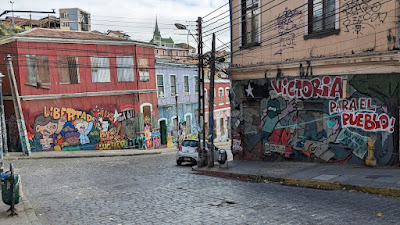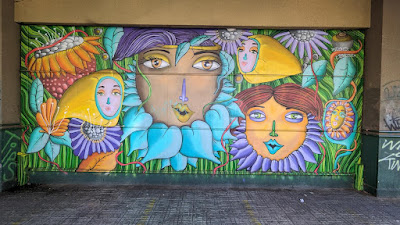Although this is the Tucson Murals Project, once in a while I include murals from another place. Last time, I showed street art in one of the biggest cities in cental/southern Chile, Valdivia. If I'd realized then how much more spectacular the street art is in Valparaíso, I might have waited and only posted here. But if that was good, this is even better!
For a larger view of any mural, click/tap on it.
Overview
I'll start with an overview of Valpo (as locals call it), say a bit about what's behind graffiti, then show lots of photos — mostly, non-graffiti murals. There are plenty of spectacular non-graffiti murals! Unfortunately, I didn't have time to edit all 70 of these photos… so they're a bit rough.The city is in a spectacular setting on the Pacific coast, with buildings along streets that climb steeply into hills. (A series of acensores — basically, outdoor elevators — save pedestrians a real workout getting where they're going.) But, like the other cities I've visited, businesses and homes are marred — or, if you prefer, decorated — by graffiti everywhere. Here's an example from the side of a hill overlooking the coast below: My first full day, I walked for nine or ten hours. Almost everywhere I walked, there was street art — usually, graffiti — on both sides, reaching at least two or three meters (up to 10 feet) high. Although I didn't visit much of Chile, graffiti was almost everywhere I went… but Valpo takes it to a higher level. I also saw literally hundreds of murals — and that was avoiding the side streets and alleys where I didn't feel safe going. (There's lot of crime here.) Valparaíso is known worldwide for its murals, and it's obvious as soon as you hit the streets. Here's some of what I saw:
| Although a lot of graffiti is a bunch of letters — for instance, the artist's name — there's much more behind it. I've known some of what's behind this kind of street art, but I learned more on a street art tour from Valpo Street Art Tours. That's how I started my weekend here. (That's their logo to the right. The heart you'd usually see has been replaced by a spray paint cap. 😎) |
#1: Muralismo (muralism) that we see in the Americas started in Mexico in the years of the Revolution (around 1920) with artists like Rivera, Orozco and Siqueiros painting large murals on politics and people’s rights. (You can still see their work on public buildings all around Mexico.) Siqueiros came to Chile in the 1940s at the invitation of Pablo Neruda, a communist (and Nobel laureate in poetry) who wanted to spread the word in a big (literally!) way.
I don't have photos of any of the earliest murals.Here's a mural with communist themes… ironically, the mural is on what's now a popular restaurant, Gato en la Ventana: The first mural here was painted by the BRP (Brigada Ramona Parra), the first muralist group in Chile, in the late 1960s. The current mural dates from 2019.
#2: In Tucson, it used to be that murals wouldn't be tagged (written on with graffiti). But in the past decade or so, taggers have started to trash murals too. The guide said that, when a mural has been tagged, another artist will recognize the tagger and write TOY or TOYS over their tag. That means “Tag Over Your Sh*t”. (I found more info on the GraffitiHeart.org Glossary and graffiti.fandom.com.) Here's our guide pointing out an example: #3: Graffiti here doesn't often mark territory of, say, a gang. It's more designed as art — often, the artist's name. Although graffiti is illegal here, there's no stopping it: If a building is cleaned one day, she said, the next day it will have been painted again. Here's a business that obviously hasn't tried to clean their front side:
#4: The term graffiti came from ancient Rome. Our guide said the word came from graphite, the material used to make the graffiti. The article History of Graffiti in Rome: from Pompeii to the Metro B (which is interesting reading about graffiti in general!) says that Britannica traces the word back to the Italian graffio, meaning “scratch.”
OK, enough of the lecture!
Murals about their location
A couple of blocks from my hotel was a hospital. Murals there were about — no surprise — medicine:Un Kolor Distinto
This couple from Valparaíso have gone from painting simple graffiti — throw-ups, which are usually a few letters or a word in puffy “marshmallow” style, our guide said — to painting high-rise buildings. (Their story, on a web page from 2014 that I hope doesn't vanish, is UnKolorDistinto: Valparaiso’s Street Artists Sammy and Cynthia.) Here are a few of their works.This mural starts from a plant at street level:
The bottom of the next mural surrounds a roll-up door which, luckily, was closed while I was there:
And the front of a store, from right to left:
Lots more photos!
These are in no particular order. I'll add comments above a few of them:The next mural shows a cat: “Juan Carlos 2013-2019.” It says “Sin liberación animal, no hay revolución social” (“Without animal liberation, there is no social revolution”):
The whole mural followed by a closeup of the left side:
There are lots of stray dogs in Valpo! This one is taking a snooze at a market in front of a mosaic mural:
The next muralist, DRË, is a fan of science. His signature is in the shape of an organic molecule:
Next time, it's back to our regularly scheduled Tucson murals!









































































No comments:
Post a Comment